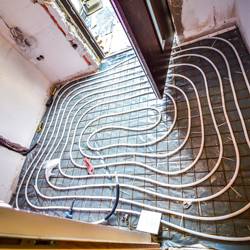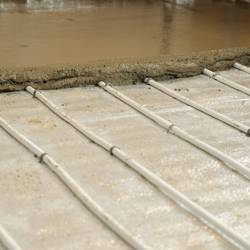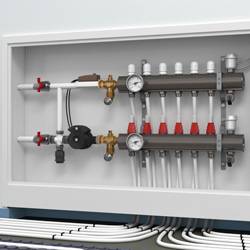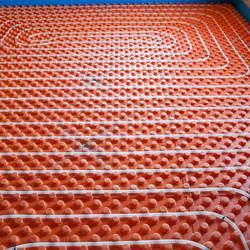Radiant heating systems supply heat directly to the panels in the wall, ceiling, or to the floor of a house.
Infrared radiation is used by the system to transfer radiant heat from the hot surface to the people inside the room or the room itself. Radiant heating is similar to experiencing warmth when near a stovetop.
Radiant Floor Heating
 Slaves during the Roman Empire are required to fan wood-burning fires under the floors and to make sure that the heat generated would travel from under the floor to reach the surface. Radiant floor heating allows heat conduction through the floor surface rather than through the air.
Slaves during the Roman Empire are required to fan wood-burning fires under the floors and to make sure that the heat generated would travel from under the floor to reach the surface. Radiant floor heating allows heat conduction through the floor surface rather than through the air.
Radiant Ceiling Heating
Radiant heating is most effective when there minimal buffer material separating the exterior and interior parts of the house. The thinner layers on the ceiling side make it possible for heat to be transferred more efficiently into the air of the room. Radiant ceiling heating is perfect for rooms between 8 and 12 feet tall, especially during summertime wherein it functions as an inexpensive air conditioning system by running cool water through its hydronic setups.
Radiant Wall Heating
 Radiant heating uses the ‘line of sight’ principle, meaning you’ll get warm fast and easy the inexpensive way if there are fewer layers that separate you from the heating elements. Because the heating panels have to be installed vertically, any space around your house can be heated on multiple levels. Since cold air is being constantly pushed down by warm air, this cycle makes radiant wall heating an effective fix for winter chills.
Radiant heating uses the ‘line of sight’ principle, meaning you’ll get warm fast and easy the inexpensive way if there are fewer layers that separate you from the heating elements. Because the heating panels have to be installed vertically, any space around your house can be heated on multiple levels. Since cold air is being constantly pushed down by warm air, this cycle makes radiant wall heating an effective fix for winter chills.
Advantages
Radiant heating provides more efficient heating than forced-air heating or baseboard heating because there is a minimum duct loss. With radiant heat, there is zero distribution of allergens unlike when forced air systems are used. Hydronic or liquid-based radiant heating is also more appropriate for areas with high electricity prices or homes off the power grid.
Types
 Radiant heating systems come in two primary types, electric and hydronic. Electric radiant heating systems utilize electric cables or mats for heat provision. In contrast, hydronic radiant heating systems allow hot water to pass through PEX tubing to provide warmth in a space. Whether your home is newly constructed or is already built without previous heating system installed, radiant heating systems can be set up in it. The type of installation will depend on the structure of your home.
Radiant heating systems come in two primary types, electric and hydronic. Electric radiant heating systems utilize electric cables or mats for heat provision. In contrast, hydronic radiant heating systems allow hot water to pass through PEX tubing to provide warmth in a space. Whether your home is newly constructed or is already built without previous heating system installed, radiant heating systems can be set up in it. The type of installation will depend on the structure of your home.
Benefits
Budget-conscious homeowners can benefit so much from having a radiant heating system. It is 25 to 50 percent less to run and maintain as long as it is properly designed and cared for, plus its life expectancy can be up to 40 years. A conventional heating system is less expensive to install but it can only last up to 25 years, maximum. Besides, installing a radiant heating system can increase your home value if you‘re planning a resale because home buyers see this as highly desirable option when shopping for a new house.
Electric Radiant Floor Heating
 Electric radiant heated floors come into two available systems: first, where electric cables are installed into the floor; second, where electrically conductive plastic mats are built on the subfloor below a floor covering such as stone, hardwood, tiles, etc.
Electric radiant heated floors come into two available systems: first, where electric cables are installed into the floor; second, where electrically conductive plastic mats are built on the subfloor below a floor covering such as stone, hardwood, tiles, etc.
Electric radiant heated floors when combined with a thick floor covering or anything with a significant thermal mass is a cost-effective solution for sub-zero temperatures during winter.
Hydronic Radiant Floor Heating
Hydronic or liquid radiant heated floors are the most commonly used systems for heating-dominated climates. Heated water comes from a boiler and passes through installed tubing under the floor. The flow of heated water can also be controlled using zoning thermostats, pumps or valves that regulate the temperature for each room around the house. The cost of installation of hydronic radiant heated floors will depend on its type, the home size, floor covering, and the cost of labor.














Write a Comment